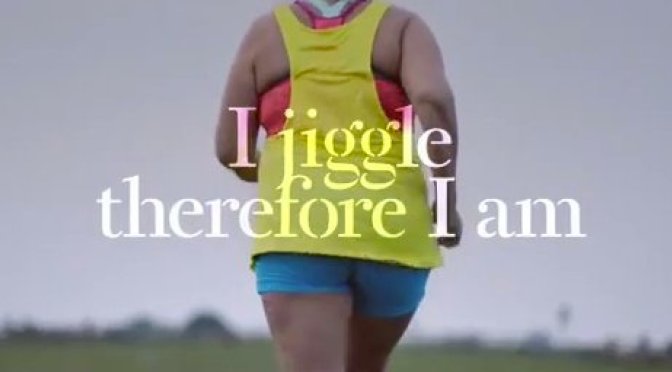It seems sports companies have realised that average-looking women play sport. Perhaps, even, god forbid, are good at it. At least that’s what a recent swathe of sports ads would like us to believe. Lately we’ve been treated to a wave of commercials empowering women to get active. Women panting, jiggling, sweating, flab swaying, limbs flying, hair wet, it seems, are no longer an embarrassment.
After years of watching slim, gorgeous people training and racing towards the finish line, shiny bodies glimmering, finally it feels like images of imperfect female bodies doing sport are ok too. Are advertisers getting braver? Or are they now reverting to shaming rather than aspiration? A carrot or a stick?
The statistics show women do significantly less sport than men. In the USA, 1.9 million fewer women than men participate in sport at least once a month. In the UK, the numbers are even more telling, with two million fewer women than men being active. Research also found that 48% of British girls interviewed believed that getting sweaty is “not feminine”. To counter these, Sport England released a promo last year called ‘This Girl Can’ featuring sweat-covered, voluptuous bodies doing sports, set to the busting beat of Missy Elliot’s Get Ur Freak On. It quickly went viral, earning 37 million views to date. The first words onscreen, “I jiggle therefore I am,” were a battle-cry for many women, with independent research revealing that the campaign was effective in both the short and the long term. Over a year on, 2.8 million British women aged 14 to 40 say they have done ‘some or more activity’ as a result of watching the campaign. It was positive, and energetic, and made women feel good about their bodies no matter their size.
If the goal is to inspire women to sweat, sports clothes brands clearly have the most to gain. Obviously women getting active means higher purchases of ‘active-wear’ but women also buy more items of clothing per year than the menfolk. Which means return on advertising investment can be more efficient. Nike is clearly leading from the front. Whilst Adidas’s #Mygirls campaign and Reebok’s Women Run The World #BeMoreHuman rely on time-worn cliches about women being badass (and always using hashtags), Nike seems to be at least trying. Last year they produced the campaign ‘Last’, in which a female runner pants her way to the finish line in last place, fighting self-doubt all the way. “You are not a runner. You are especially not a marathon runner,” she tells herself.
Undoubtedly based on this success, this year Nike released the ‘Better For It – Inner Thoughts’ campaign. In this series, deadpan voice-overs mull through the myriad of fears that prevent women from doing exercise; mirrors at the gym, judgement from others in the class, and, most obviously, fear of failure. But ‘Better For It’ hits a different chord. While ‘Last’ showed a full-bodied woman, ‘Better For It’ reveals women who’s bodies are not too unlike the so-called ‘models’ in class who intimidate them. Its a return to the beautiful bodies we’ve seen a thousand times before.
Whatever the type of bodies portrayed, one thing is for sure – the framing of these ads is very different to the traditional male-targeted examples that we’re used to seeing on TV. We all know the ones; they’re all about shiny, tanned, sinewy young bodies (or better yet, celebrity athletes), always training hard, usually shot in profile. The narrative is always the same – try hard, strive for excellence and then, obviously, win. Here, the sportsman is hero, and winning is both the final goal, and an easy equation of hard work and time.
But these female-perspective commercials set a far lower benchmark; they’re set on inspiring women to move. In these very different advertisements, the real win is far smaller. Simply finishing the race, whatever place that might be, or even sometimes just starting in the first place, are all we can hope for. The challenges are smaller in scope, and completely internalised. The voice-overs articulate self-doubt, self-consciousness, and often wondering if it is worth continuing.
But then of course, there are the fails. Apple have tried their own version – replacing self-doubting, average-looking women with the decidedly un-average Taylor Swift. Despite her slim physique, she still tries to establish that she’s just a normal human girl you guys! by tripping over her treadmill at the end. It’s silly, yes, and more than a little patronising, but still, they seem to be trying.
